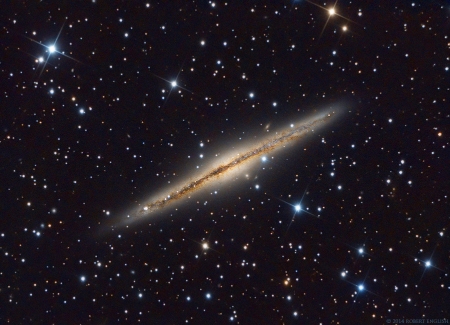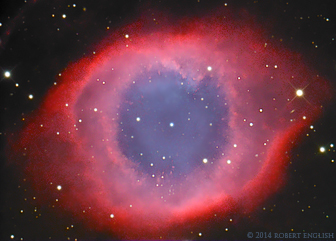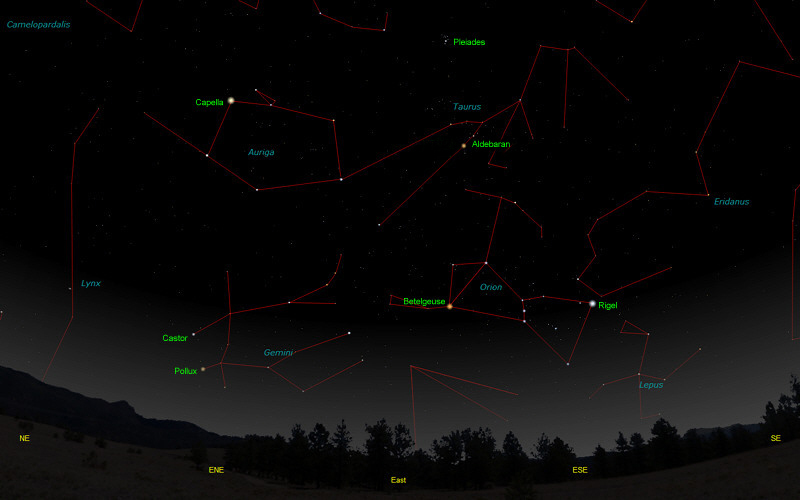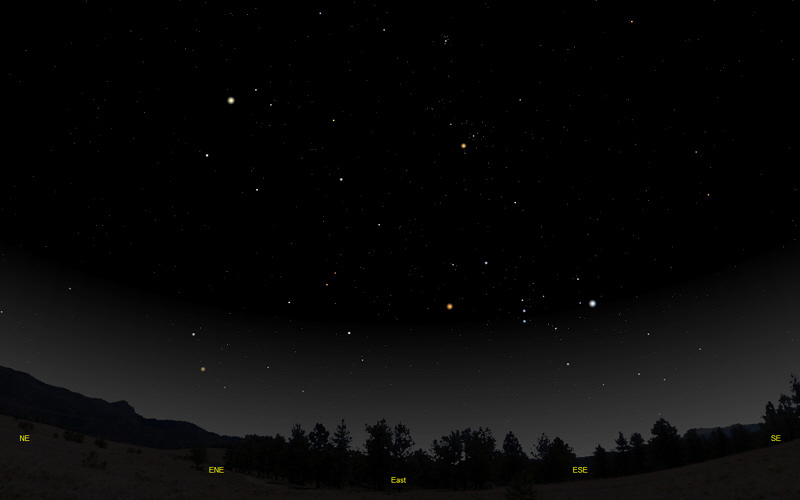The purpose of this feature is to give scout leaders, educators and naturalists an idea of some of the natural events coming up each month. We will try to cover a variety of natural events ranging from sky events to calling periods of amphibians, bird and mammal watching tips, prominent wildflowers and anything else that comes to mind. We will also note prominent constellations appearing over the eastern horizon at mid-evening each month for our area for those who would like to learn the constellations. If you have suggestions for other types of natural information you would like to see added to this calendar, let us know! Note: You can click on the hyperlinks to learn more about some of the featured items. To return to the Calendar, hit the "back" button on your browser, NOT the "back" button on the web page. All charts are available in a "printer friendly" mode, with black stars on a white background. Left clicking on each chart will take you to a printable black and white image. Please note that images on these pages are meant to be displayed at 100%. If your browser zooms into a higher magnification than that, the images may lose quality. Though we link book references to nationwide sources, we encourage you to support your local book store whenever possible. Notes and Images From September 2014 This time of year, after a cold front has passed through, we're sometimes treated to beautiful starry nightscapes. The Great Square of Pegasus is high in the sky in the early evening, and the stars of Andromeda trail down from the northeast corner of the Square towards the eastern horizon. On moonless nights, far from streetlights, you feel the immensity of the universe. Tree crickets play their melancholy songs, their long low trills slowed by the cool temperatures. If you start at the northeast corner of the Great Square and move down the stars of Andromeda, counting as you go, you will first come to delta Andromeda, and then the red-tinged star Mirach. The Andromeda Galaxy is visible to the naked eye above this star, looking like a small faint cloud. It's quite beautiful in binoculars. If you continue downward from Mirach, you will reach the star gamma Andromeda. Just below gamma is the striking edge-on galaxy NGC-891. NGC-891 is commonly known as the Outer Limits Galaxy, as it was the first of several galaxies shown as the credits were rolled on the 1960's sci-fi program, The Outer Limits. As others have noted, the galaxy looks a bit like a flying saucer wheeling its way through the star field. Appearances are deceiving, though. All of the stars in the above image are part of the Milky Way Galaxy, and are much closer than NGC-891. In fact, if you imagine looking out your window on a snowy evening, the stars would be like the flakes of snow on your window pane, a foot away. The galaxy would be like a distant porch light on the side of a ridge, two miles away. The distance from one side of the galaxy to the other is a little over 100,000 light-years, and the dark clouds of obscuring dust seen in silhouette extend for hundreds of light-years. The galaxy's distance from us is around 30 million light-years. Many small background galaxies can be seen in the high resolution version of the image. Click the image above to see it. What would it be like to be inside the rim of NGC 891 looking outward? Well, we have a pretty good idea. It would be the same view we have when we look outward towards the Milky Way. In fact, wide-field all-sky images of the Milky Way show a view that looks surprisingly like NGC-891. Check out the view here.
Sky Events for November 2014: The Leonid Meteor Shower peaks in the morning hours of November 17th. Evening Sky: Mars is less than 6 seconds of an arc now in apparent diameter. It will slowly move across the constellation of Sagittarius this month. Morning Sky: Jupiter rises about 11:39pm in Leo at the beginning of the month. For the best views, observe it close to dawn when it is higher above the horizon. Mercury reaches greatest elongation from the Sun on November 1st. At that time you can find it about 10 degrees above the eastern horizon about 45 minutes before sunrise. It will be above and to the left of the bright star Spica in Virgo. By November 8th the fleet-footed planet will have passed Spica and will be below and to the left of the star.
Constellations: The views below show the sky looking east at 9:30pm CST on November 15th. The first view shows the sky with the constellations outlined and names depicted. Star and planet names are in green. Constellation names are in blue. The second view shows the same scene without labels. Auriga, the Charioteer, with its bright star Capella is prominent in the northeast. Look for the bright stars Castor and Pollux as the constellation Gemini, The Twins, clears the horizon. Jupiter will be nearby. In the southeast, mighty Orion clears the horizon with its bright stars Betelgeuse and Rigel. Note the difference in color between the two stars. Betelgeuse is a red giant and looks orange. Rigel is very hot supergiant and looks bluish. Looking at the center of the three "sword" stars with binoculars, you can see M42, the Orion Nebula. Just poking its head above the horizon is Lepus, The Hare.The ghostly Helix Nebula is visible in the far southern sky this time of year in Aquarius. Its faint glow can be seen on dark moonless nights in small telescopes and large binoculars. Because it is one of the closest planetary nebulae, it looks surprisingly large, almost the apparent diameter of the full moon. The eye is unable to pick up the colors shown in the image above, taken in September of this year. Above Aldebaran, look for the Pleiades, a beautiful open star cluster. Also called the "Seven Sisters," it has been known since antiquity. In Japan it is known as Subaru, and the Subaru automobile is named for this cluster. Before the Gregorian calendar reform in 1582, the Pleiades culminated around midnight on October 31st, and it has been traditionally associated with Halloween.
On Learning the Constellations: We advise learning a few constellations each month, and then following them through the seasons. Once you associate a particular constellation coming over the eastern horizon at a certain time of year, you may start thinking about it like an old friend, looking forward to its arrival each season. The stars in the evening scene above, for instance, will always be in the same place relative to the horizon at the same time and date each November. Of course, the planets do move slowly through the constellations, but with practice you will learn to identify them from their appearance. In particular, learn the brightest stars for they will guide you to the fainter stars. Once you can locate the more prominent constellations, you can "branch out" to other constellations around them. It may take you a little while to get a sense of scale, to translate what you see on the computer screen or what you see on the page of a book to what you see in the sky. Look for patterns, like the stars that make up Orion.The earth's rotation causes the constellations to
appear to move across the sky just as the Sun and the Moon appear to do.
If you go outside earlier than the time shown on the charts, the constellations
will be closer to the eastern horizon. If you observe later, they will
have climbed higher. As each season progresses, the earth's motion around the Sun causes the constellations to appear a little farther towards the west each night for any given time of night. If you want to see where the constellations in the above figures will be on December 15th at 9:30pm CST, you can stay up till 11:30pm CST on November 15th and get a preview. The westward motion of the constellations is equivalent to two hours per month. Recommended: Sky & Telescope's Pocket Star Atlas is beautiful, compact star atlas. A good book to learn the constellations is Patterns in the Sky, by Hewitt-White. You may also want to check out at H. A. Rey's classic, The Stars, A New Way to See Them. For skywatching tips, an inexpensive good guide is Secrets of Stargazing, by Becky Ramotowski. A good general reference book on astronomy is the Peterson
Field Guide,
A Field Guide to the Stars and Planets, by Pasachoff. The book retails for around $14.00. Starry Night has several software programs for learning the night sky. Visit the Starry Night web site at www.starrynight.com for details. The Virtual Moon Atlas is a terrific way to learn the surface features of the Moon. And it's free software. You can download the Virtual Moon Atlas here. Cartes du Ciel (described in the monthly notes above) is a great program for finding your way around the sky. It is also free, and can be downloaded here. Apps: We really love the Sky Safari Pro application described here. For upcoming events, the Sky Week application is quite nice. Both apps are available for both I-phone and Android operating systems. The newest version, Sky Safari 4, is available here.
Amphibians:
We think of November as the quietest time of year for Tennessee frogs and toads. However, some song can still occasionally be heard. Listen for Spring Peepers, Upland Chorus Frogs and Southern Leopard Frogs. Checking around ponds at night with a flashlight held next to your temple will often show the eye shine of Southern Leopard Frogs, Green Frogs and Bullfrogs. As in October, you can locate many of the frogs and toads that have been calling more frequently earlier in the year by driving the back roads slowly on rainy nights. This is a two person job. One person watches the road for amphibians and one person looks out for other vehicles. Recommended: The Frogs and Toads of North America, Lang Elliott, Houghton Mifflin Co. Archives (Remember to use the back button on your browser, NOT the back button on the web page!) Natural Calendar September 2014 Natural Calendar February 2014 Natural Calendar December 2013 Natural Calendar November 2013 Natural Calendar September 2013 Natural Calendar December 2012 Natural Calendar November 2012 Natural Calendar September 2012 Natural Calendar February 2012 Natural Calendar December 2011 Natural Calendar November 2011 Natural Calendar September 2011 Natural Calendar February 2011 Natural Calendar December 2010 Natural Calendar November 2010 Natural Calendar September 2010 Natural Calendar February 2010 Natural Calendar December 2009 Natural Calendar November 2009 Natural Calendar September 2009 Natural Calendar February 2009 Natural Calendar December 2008 Natural Calendar November 2008 Natural Calendar September 2008 Natural Calendar February 2008 Natural Calendar December 2007 Natural Calendar November 2007 Natural Calendar September 2007 Natural Calendar February 2007 Natural Calendar December 2006 Natural Calendar November 2006 Natural Calendar September 2006 Natural Calendar February 2006
Natural Calendar December 2005
Natural Calendar November 2005
Natural Calendar September 2005
Natural Calendar February 2005
Natural Calendar December 2004
Natural Calendar November 2004
Natural Calendar September 2004
Natural Calendar February 2004
Natural Calendar December 2003
Natural Calendar November 2003
Natural Calendar September 2003 Natural Calendar February 2003 Natural Calendar December 2002 Natural Calendar November 2002 Nature Notes Archives: Nature Notes was a page we published in 2001 and 2002 containing our observations about everything from the northern lights display of November 2001 to frog and salamander egg masses. Night scenes prepared with The Sky Professional from Software Bisque All images and recordings © 2014 Leaps |
|||||




